This post contains affiliate links. Please see our disclosure policy.
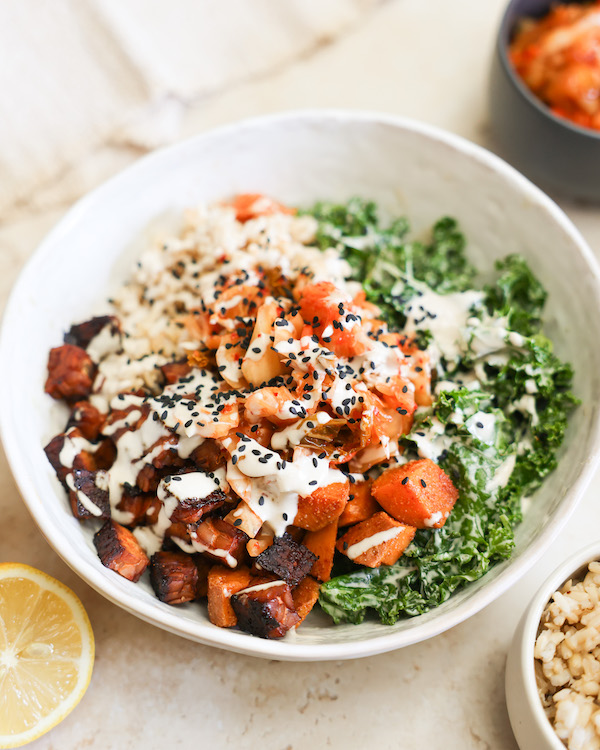
Not all Buddha bowls are created equal. Learn how to make a truly delicious and nutritious Korean-inspired Buddha bowl that will satisfy your taste buds and nourish your body. Grab a fork, I hope you’re hungry!
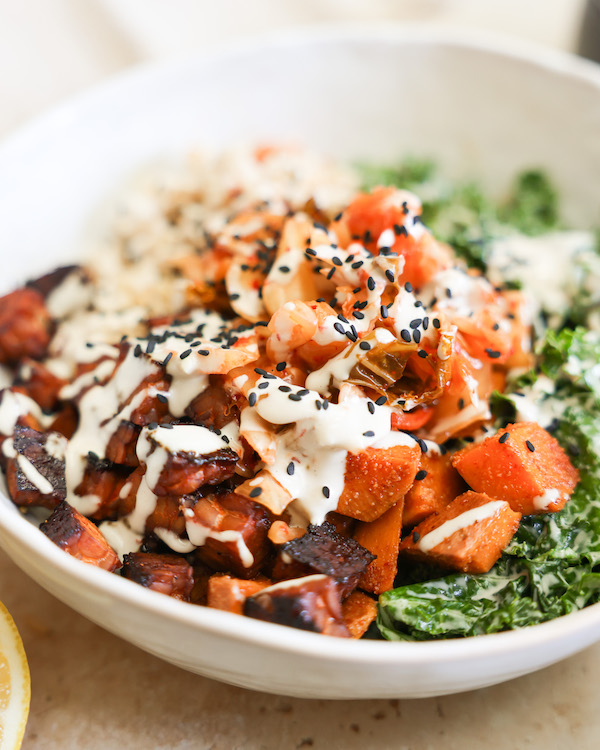
If I could eat one dish everyday it would definitely be this delicious Buddha bowl. I love Buddha bowls, but they’re not all the same. As pretty as these veggie and grain bowls can be, they often lack flavor and soul. This Korean-inspired Buddha bowl is bursting with flavor, texture, and nutrition. Made with roasted sweet potatoes, gochujang marinated tempeh, massaged kale, and kimchi; this buddha bowl is the perfect balance of sweet, savory, and spicy. With all the right textures, down to the crunchy black sesame seeds for garnish, you cannot go wrong with this bright and beautiful bowl.
Why We Love It
- Balanced and healthy
- Delicious
- Perfect for meal prep
- Simple wholesome ingredients
- High in protein and fiber
What is a Buddha Bowl
A Buddha bowl is a vegetable and grain bowl inspired by the Macrobiotic philosophy of nutrition. Macrobiotic is an eating and lifestyle protocol that originated in Japan in the 60s. While I do not subscribe to many of the principals of this way of eating, I love the concept of the balanced Buddha bowl.
The 5 key components of a Buddha bowl are:
1. WHOLE GRAIN: brown rice, quinoa, millet, farro, etc
2. LEGUME: tofu, black beans, lentils, roasted chickpeas, etc
3. STARCHY VEGETABLE: sweet potato, butternut squash or pumpkin
4. GREEN VEGETABLE spinach, broccoli, kale, cauliflower, etc
5. HEALTHY FAT: avocado, nut butter, nuts, seeds, tahini, olives
The most common whole grains used in modern American bowls are brown rice and quinoa, though any can be used. The legume category includes beans, lentils, and soy products like tofu and tempeh. You probably can guess that my starchy vegetable of choice is always a sweet potato. And healthy fats are often avocado and tahini sauce, not oil based dressings and sauces. The macrobiotic protocol recommends certain amounts of each of these food categories, but I don’t follow their rules. I like to build my bowl with an equal amount of everything but the healthy fat––maybe an extra helping of green veggies. The healthy fat I add for a satisfying last touch. Buddha bowls are colorful meals; almost like an entree salad that hasn’t been tossed quite yet.
One of my favorite things about Buddha bowls is that they make meal prep easy. Roast, steam, boil, and wash a variety of veggies and grains on your day off, then mix and match the ingredients throughout the week to create new and exciting combinations. Here’s a link to a whole Buddha bowl meal plan I created.
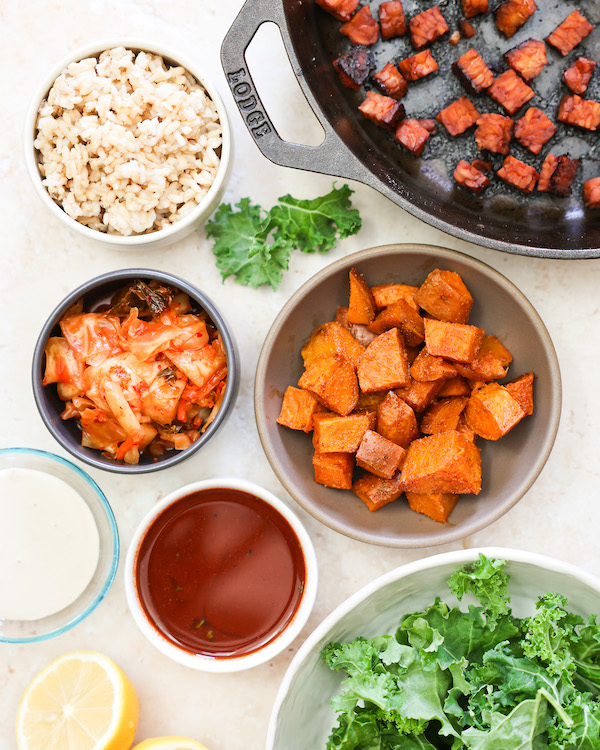
The Star Ingredients
This Korean-inspired Buddha bowl is made with some of the most flavorful and nourishing ingredients. As a Korean inspired recipe I utilized gochujang paste to give the marinated tempeh a rich umami flavor and subtle spiciness. Keep reading to learn more about this and the other ingredients.
Gochujang paste
Gochujang is a Korean red pepper paste made from fermented soy beans, red chili peppers, and sugar. It’s delightfully sweet, savory, and spicy all at the same time. For this recipe we use gochujang in the tempeh marinade. Gochujang is blended with soy sauce, balsamic vinegar, and maple syrup to create a silky sauce. The tempeh is then marinated for at least 4 hours, but overnight is best. Gochujang is sold in different spiciness levels, so choose the one that is best for you. Look for gochujang at your local Asian grocery store, health food stores, and online. Be sure the one you buy is vegan.
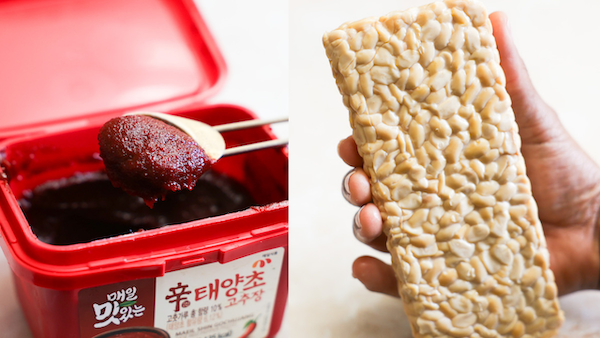
Tempeh
Perhaps my favorite soy product is tempeh. Tempeh is a fermented soy bean cake. Like tofu, marinated tempeh soaks up the flavor of its marinade, and has a meaty texture when cooked. Though, unlike tofu, the meaty texture of tempeh is a lot denser. Tempeh is a terrific source of plant-based protein––18 grams per serving. Look for it at your local health food store.
Kimchi
Another Korean culinary gem is kimchi, spicy fermented cabbage. If you like sauerkraut and pickles, you will love kimchi. Kimchi has a tart and tangy flavor with the perfect crunch. As a fermented product, it is rich in probiotics. Kimchi is made with cabbage, green onion, peppers, and carrots. It is often sold with shrimp paste added, so be sure to check the label. Vegan kimchi is available at Asian grocery stores and health food stores.
Kale
It’s not a Buddha bowl without the green vegetable. Any will work in this recipe, but I like kale best. To make it tender and delicious, massage the kale with the tahini dressing. Massaging kale breaks down the leaf’s cell wall which helps your body digest and metabolize more of this superfood’s nutrients.
Tahini
Tahini is a creamy smooth sesame seed paste. It is a great source of calcium, and one of my favorite sources of healthy fat. In this recipe, tahini is used to make a luxurious sauce that can be drizzled on almost anything.
Sweet Potato
No bowl of mine would be complete without my favorite ingredient. Roasted sweet potatoes add sweetness and earthiness to balance out the savory flavors in the bowl. They are also a fantastic source of beta-carotene, vitamin C, and fiber. Use any kind of sweet potato for this bowl. I usually roast a blend of orange sweet potatoes and white fleshed Korean sweet potatoes. Korean sweet potatoes are starchier than “American” sweet potatoes and have a drier texture. I love them both!

Tips for a better bowl
- Marinate the tempeh overnight for the most flavor.
- Any type of soy sauce can be used, but I usually buy full sodium tamari or shoyu. Tamari is gluten-free Japanese soy sauce. Shoyu is another style of Japanese soy sauce.
- Don’t throw away the tempeh marinade. This salty and spicy sauce can be drizzled over the finished bowl for extra flavor.
- Double the tempeh recipe if you’d like to eat this throughout the week.
- Don’t heat the kimchi. It is loaded with beneficial probiotics. Add this to your bowl once the other ingredients have been warmed (especially when reheating leftovers).
- The way I wrote the instructions will allow for the most efficient cook time. For examples, the tempeh and sweet potatoes should be roasted together, and the brown rice should be cooking while they are roasting. While these cook, you can make the tahini sauce and wash the kale.
Swaps
As in all Buddha bowls the ingredients can be swapped for others in the same category. For example, you can use red cabbage instead of kale; kabocha squash instead of sweet potatoes; roasted pumpkin seeds instead of sesame seeds; and avocado instead of tahini sauce.
If you don’t like tempeh you can use the same recipe to marinate tofu. Roast the tofu like you would the tempeh.
How to store a buddha bowl
Because all of the ingredients require different, or no, heating times I store each component of the Buddha bowl separately in an air tight container in the fridge.
More vegan bowl recipes
Better-than-Chipotle Vegan Burrito Bowl
Balanced Maple Mustard Tempeh Bowl
I’ve been making this exact vegan buddha bowl recipe for a decade, and yet somehow the recipe is only now making its way to the blog. That says more about my organization skills than it does this recipe. And I apologize in advance for keeping this delicious bowl under wraps. I did share a very similar bowl in a YouTube video once. In return for not sharing the recipe sooner, I give you full permission to watch this embarrassing 10 year old video and laugh.
Save now, cook later.

Korean-Inspired Vegan Buddha Bowl
Video
Ingredients
Marinated Tempeh
- 1 block tempeh, cut into cubes
- 3 tbsp soy sauce
- 3 tbsp balsamic vinegar
- 2 tbsp gochujang paste
- 1 tbsp maple syrup
Sweet potatoes
- 3 sweet potatoes, assorted orange and Korean varieties
- 1 tbsp neutral oil
- 1/2 tsp garlic powder
- 1/2 tsp smoked paprika
- 1/2 tsp sea salt
Tahini Sauce
- 1/4 cup tahini
- 1 small clove of garlic, minced
- 2-4 tbsp fresh lemon juice
- 1/4 cup water + more to thin
- 8 cups raw kale
- 4 cups cooked brown rice
- 2 cups vegan kimchi
- 4 tsp black or white sesame seeds
- 2 tbsp fresh chives or scallion
Instructions
Marinated tempeh
- In a bowl combine soy sauce, balsamic vinegar, gochujang, and maple syrup. Use a fork or small whisk to stir and break up any chunks of gochujang.
- Add the cubed tempeh to the bowl with the sauce––or another container with a lid––and stir to coat thoroughly. Cover and set in the refrigerator to marinate for at least 4 hours, or overnight.
- To cook the tempeh Preheat the oven to 375° F. Transfer the tempeh pieces to an oven-safe skillet or baking dish and roast for 20 minutes. They can be in the oven at the same time as the sweet potatoes.
Sweet potatoes
- Toss the cubed sweet potatoes with oil, garlic powder, smoked paprika, and salt. Transfer to a baking dish and roast for 40-45 minutes, or until tender and fragrant.
Tahini sauce
- Combine the tahini, garlic, lemon juice, and water in a bowl or jar with a lid. Stir well (or shake if you are using a jar). Add more water to thin, 2 tbsp at a time.
Assemble the buddha bowl
- Massage the kale with a few tablespoons of the tahini sauce and a pinch of sea salt. If you are making one bowl at a time, do this in the bowl you intend on eating out of. If you are making the entire serving (4 bowls), massage the kale in a larger mixing bowl then transfer it into serving bowls.
- Add a scoop of brown rice, tempeh, and sweet potatoes to the bowl. Top with kimchi and a drizzle of tahini sauce. Garnish with sesame seeds and fresh herbs (chives or scallion).
Notes
Save the leftover tempeh marinade to drizzle over the finished bowl.
Follow the instructions on your brown rice to cook. I always prepare brown rice in the Instant Pot. The recipe is simple: 1 cup of brown rice + 1 1/4 cup water + 1 tsp neutral oil. Pressure cook for 24 minutes, then natural steam release for at least 10 minutes.
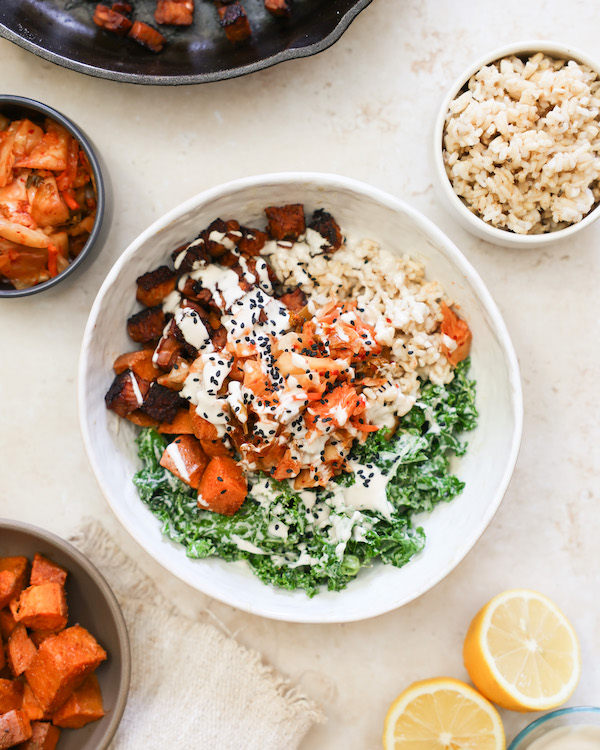
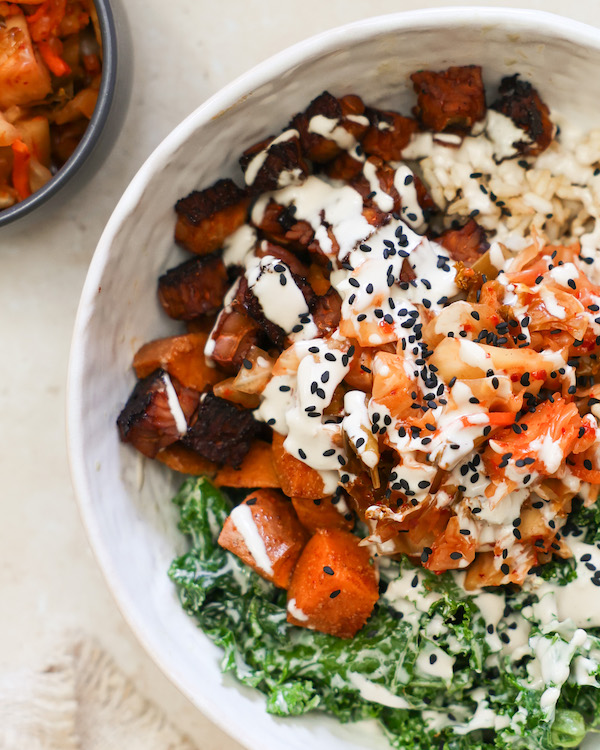
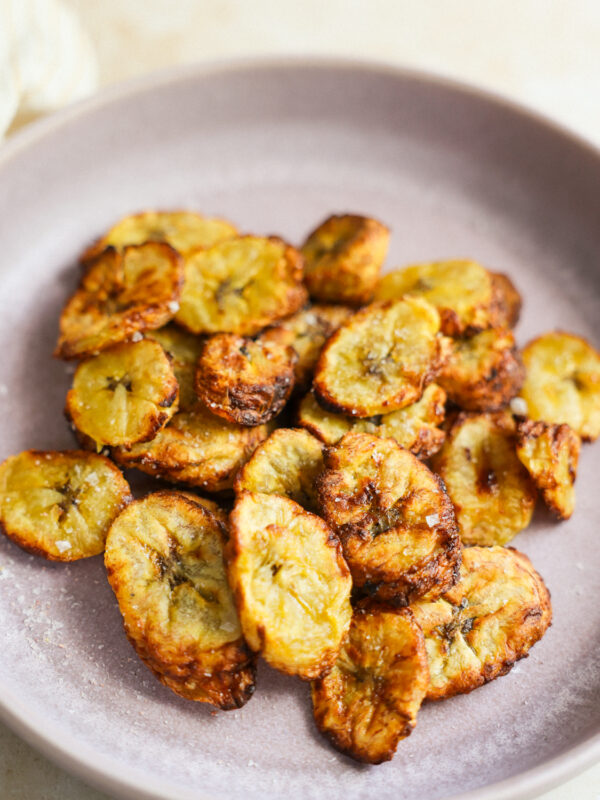
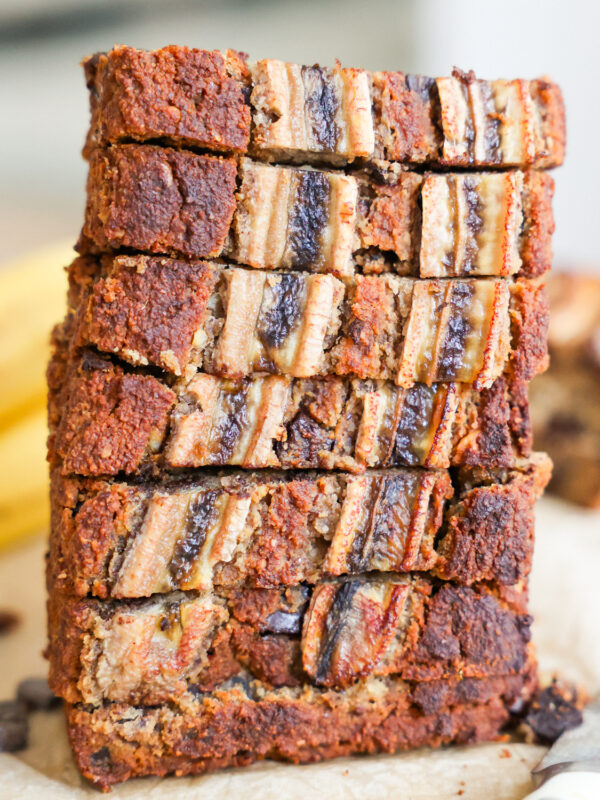

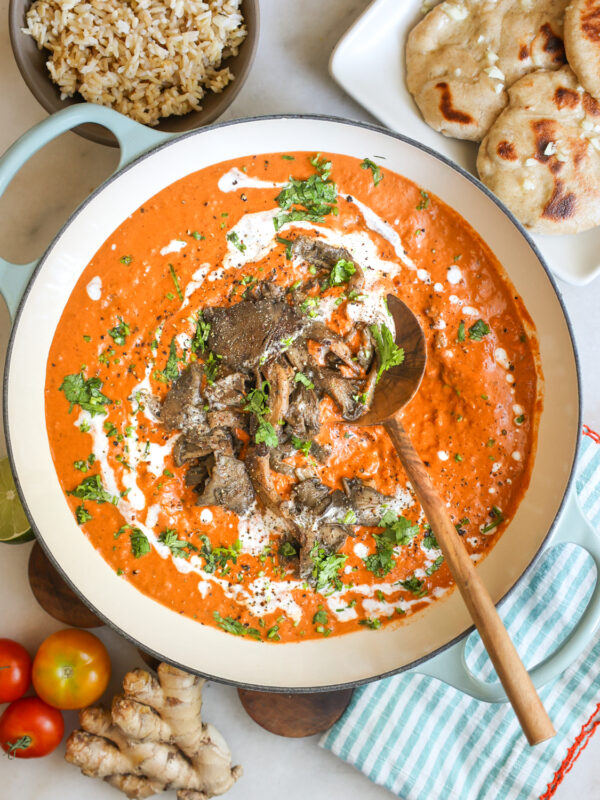






Tasty, but overall too acidic (lemon juice + kimchi). Next time, I’ll add 1 tsp of maple syrup to the dressing.
The flavors in this recipe go together really well. I prepped the tempeh and tahini dressing the night before. Easy to put together. Delicious!
So good! I ran across this recipe in one of your meal plans. I had a block of tempeh I needed to use, so I gave it a try. It’s so yummy and flavorful. If you’re on the fence, give it a try!